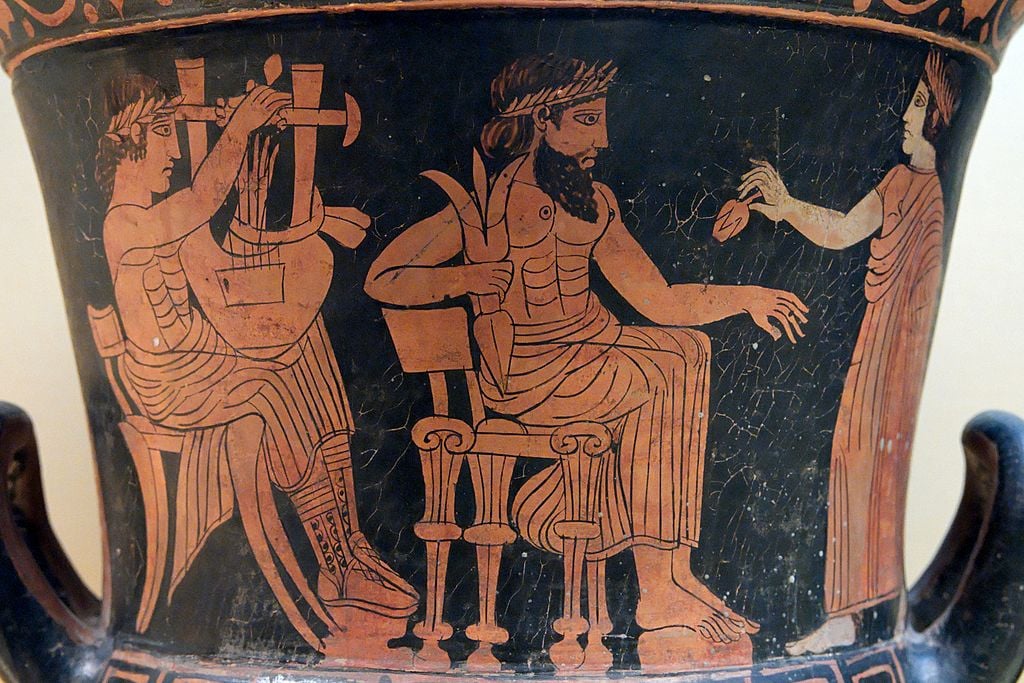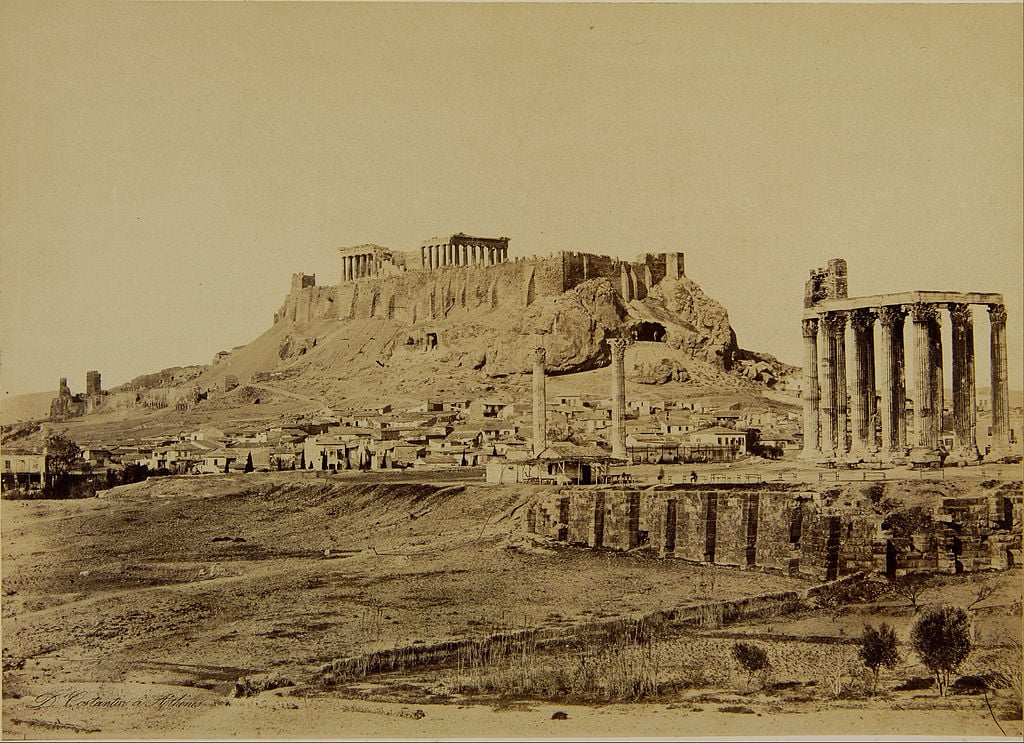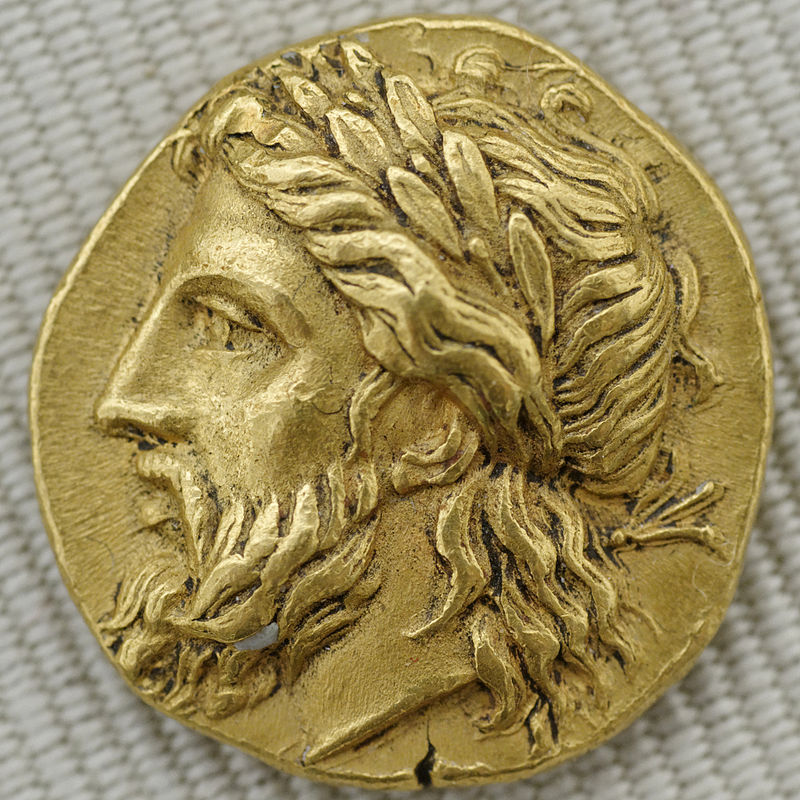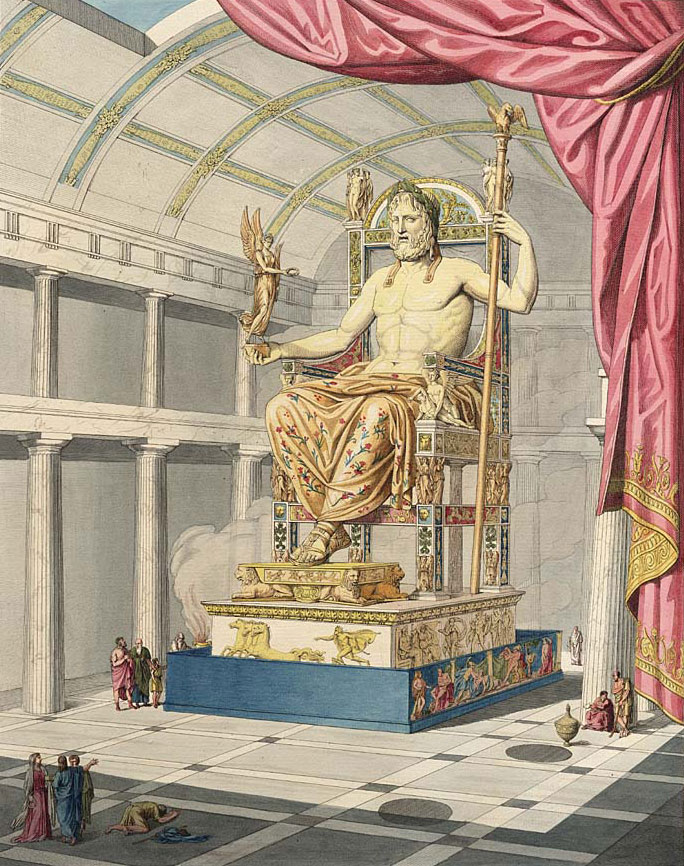
Zeus, the greatest of all the figures of Greek mythology, ruled over all the assembled gods and goddesses of the realm atop his mountain fastness on Mt. Olympus along with his wife Hera.
He was the god of the sky, lightning, and thunder in ancient Greek religion. His mythology and powers are similar, though not identical, to those of Indo-European deities such as Jupiter, Perkūnas, Perun, Indra, Dyaus, and Thor.
The most fearsome of all the ancient Greek deities in every way, he was the child of Cronus and Rhea, the youngest of his siblings, although sometimes counted as the eldest since the others required disgorging from Cronus’s stomach. He was said to have grown up on the Greek island of Naxos.
In most traditions, he is married to the goddess Hera, by whom he is usually said to have fathered Ares, Hebe, and Hephaestus. At the oracle of Dodona, however, his consort was said to be Dione, by whom, as is stated in Homer’s Iliad, he fathered the goddess of love, Aphrodite.
Zeus, the king of the gods of the Greek mythology had temples dedicated to him in Olympia, Athens, and Rome
Zeus was also infamous for his many love affairs and conquests, resulting in many divine, heroic offspring, including Athena, Apollo, Artemis, Hermes, Persephone, Dionysus, Perseus, Heracles, Helen of Troy, Minos, and the Muses.
He was respected as an “allfather” who was chief of the gods, and the one who assigned roles to the others. “Even the gods who are not his natural children address him as Father, and all the gods rise in his presence,” Homer wrote in the Iliad.
He was equated with many foreign gods of the sky and weather phenomena, as well, causing Pausanias to observe “That Zeus is king in heaven is a saying common to all men.” Zeus’ symbols are the thunderbolt, eagle, bull, and oak tree. Also known more poetically as the “cloud-gatherer” (Greek: Νεφεληγερέτα, Nephelēgereta), Zeus derives certain iconographic traits from the cultures of the ancient Near East, such as the scepter.

Some of the most iconic temples of antiquity dedicated to Zeus
Temples, statues, and other monuments dedicated to Zeus and all his permutations are scattered all around Europe. Known as “Jupiter” in the Roman world, one of his most renowned temples was located atop the Capitoline Hill in Rome itself. Now reduced to merely part of a wall, the once-majestic temple has far less left of it than either the Temple of Olympian Zeus in Athens or the Temple at Olympia itself.
Zeus played a very dominant role, presiding over the Greek Olympian pantheon. Though Homer’s “cloud collector” was the god of the sky and thunder like his Near-Eastern counterparts, he was also the supreme cultural symbol of the Ancient Greek people; in some senses, he was the embodiment of Greek religious beliefs.
His name is the Greek continuation of *Di̯ēus, the name of the Proto-Indo-European god of the daytime sky, also called *Dyeus ph2tēr (“Sky Father”). The god is known under this name in the Rigveda, and in Latin as Jupiter, from Iuppiter, deriving from the Proto-Indo-European vocative *dyeu-ph2tēr), which comes from the root *dyeu- “to shine,” and in its many derivatives, meaning “sky, heaven, god.”

Name from Indo-European deity of the sky
Fascinatingly, Zeus is the only deity in the Olympic pantheon whose name has such a transparent Indo-European etymology, pointing to the fact that worship of him was begun in the very early years of antiquity.
The earliest attested forms of the name are the Mycenaean Greek, di-we and di-wo, which were written in the Linear B syllabic script.
He is also identified with the Hindu deity Indra. Not only are they both the king of gods, but their weapon, thunder and lightning, is similar.
The leader of all the Greek gods is occasionally conflated with the Hellenic sun god, Helios, who is sometimes either directly referred to as Zeus’ eye. Hesiod, for instance, describes Zeus’ eye as effectively the sun.
The Cretan Zeus Tallaios had solar elements to his cult; “Talos” was the local equivalent of Helios.

The temple dedicated to him at Olympia had a statue that was so imposing it was known as one of the wonders of the ancient world. Created by Phidias, the master sculptor who made the statue of Athena Parthenos inside the Parthenon, it also was a massive, monumental work which was imbued with great majesty.
The Temple of Zeus, built in the second quarter of the fifth century BC, was the very model of the fully developed classical Greek temple of the Doric order. The Temple was built on an already ancient religious site at Olympia. Historians believe that the Altis, an enclosure with a sacred grove, open-air altars and the tumulus of Pelops, was first formed during the tenth and ninth centuries BC, known as Greece’s “Dark Age,” when the followers of Zeus had joined with the followers of Hera.
Pausanias visited the site in the second century AD and states that the temple’s height up to the pediment was 68 feet (20.7 meters) while its breadth was 95 feet (29 meters), and its length was an incredible 230 feet (70.1 meters).

The Chryselephantine (gold and ivory) statue of Zeus within it was an astounding 13 meters (43 feet) high, created by the sculptor Phidias in his workshop on the site at Olympia. The statue’s completion took approximately thirteen years from 470–457 BC and was one of Classical Greece’s most revered artistic works.
In AD 426, the Emperor Theodosius II ordered the destruction of the sanctuary during the persecution of pagans in the late Roman Empire; what was left of the temple was further destroyed by the earthquakes that occurred in 522 and 551 AD, which were known to have caused widespread damage in the Peloponnese.
Flooding of the Kladeos River most likely led to the complete abandonment of the area in the sixth century. Eventually, the site was covered by alluvial deposits of up to eight meters (26 feet) deep.
The site of the ancient sanctuary of Olympia, long forgotten under the silt, was identified in 1766 by the English antiquarian Richard Chandler. In May of 1829, the French team of archaeologists from the “Scientific Expedition of Morea” under the direction of Léon-Jean-Joseph Dubois and Abel Blouet, identified with certainty, and partially excavated, the Temple of Zeus for the first time.
They then took several fragments of the metopes to the Musée du Louvre with the authorization of the Governor of Greece at the time, Ioannis Kapodistrias. Systematic excavation began in 1875 under the direction of the German Archaeological Institute and has continued, with some interruptions, up to the present day.

Temple of Olympian Zeus still stands proudly in Athens
Zeus, the king of the gods in Greek mythology is frequently depicted by Greek artists in one of three poses: standing, striding forward with a thunderbolt leveled in his raised right hand, or seated in complete majesty.
Also known as the Olympieion or Columns of the Olympian Zeus, one of the best-known Temples dedicated to Zeus is the former colossal temple at the center of Athens. It was dedicated to “Olympian” Zeus, a name originating from his position as head of the Olympian gods.
Construction began in the 6th century BC, approximately the year 515 BC during the rule of the Athenian tyrants, who envisaged building the greatest temple in the ancient world, but it was not completed until the reign of the Roman Emperor Hadrian in the 2nd century AD, some 638 years after the project had begun. During the Roman period, the temple, which included 104 colossal columns, was renowned as the largest temple in Greece, and it housed one of the largest cult statues in the ancient world.
The temple’s glory was short-lived, as it fell into disuse after being pillaged during a barbarian invasion in 267 AD, a mere century after its completion. It was most likely never repaired and was reduced to ruins thereafter. In the centuries following the fall of the Roman Empire, it was extensively quarried for building materials to supply building projects elsewhere in the city.
Zeus lives on in his Temples and in the religious pantheon worldwide
Despite that, a substantial part of the temple remains today, notably sixteen of its original stately columns, and it continues to be part of a very important archaeological site of ancient Greece. Clearly visible from the Acropolis, it still stands in majesty with its backdrop of trees, the modern cityscape and the mountains of Athens.
Since Zeus was the ultimate embodiment of all pagan gods, the Seleucid ruler Antiochus IV Epiphanes, in an attempt to destroy the Jewish religion, ordered that the great Temple in Jerusalem not only be profaned but also rededicated to Zeus under the name Jupiter Olympius.
In 168 BC, Antiochus marched into the Jewish temple, directing his men to not only erect a statue of Zeus, but to sacrifice a pig on the altar there — the ultimate in desecration to the Jews.
Understandably, this led to such an outcry that there was a revolt in all Judea. Under the military leaders the Maccabees, not only were the Jews successful in driving Antiochus and his army out of the holy city, but they rededicated their Temple, lighting lamps there which miraculously burned for eight days although there was only one day’s worth of oil left in them, beginning the celebration of the festival of Hanukkah.
Remarkably, Zeus is mentioned in the New Testament twice, first in Acts 14:8–13. When the people living in Lystra saw the Apostle Paul heal a lame man, they considered Paul and his partner Barnabas to be gods, identifying Paul with Hermes and Barnabas with Zeus. Two ancient inscriptions discovered in 1909 near Lystra testify to the worship of these two gods in that city, with one of the inscriptions referring to the “priests of Zeus,” and the other mentioning “Hermes Most Great” and “Zeus the sun-god.”
The second occurrence is in Acts 28:11. The name of the ship in which the prisoner Paul set sail from the island of Malta bore the figurehead “Sons of Zeus,” or, in other words Castor and Pollux.
From far back into the human past until today and certainly far into the future, Zeus will continue to live in the imagination of mankind. Those who are fortunate enough to visit his temples in Greece can see the majesty that once was his through the stately ruins that still stand.
See all the latest news from Greece and the world at Greekreporter.com. Contact our newsroom to report an update or send your story, photos and videos. Follow GR on Google News and subscribe here to our daily email!



